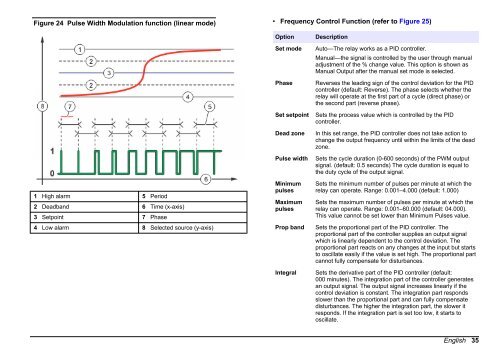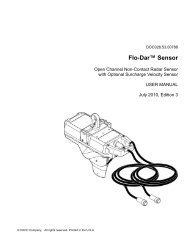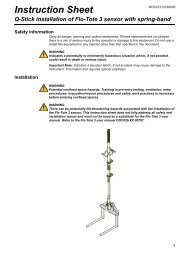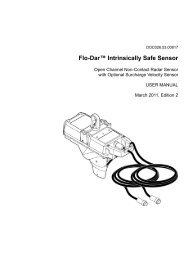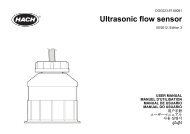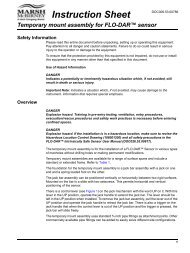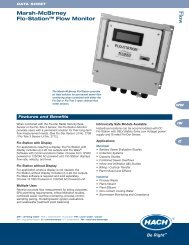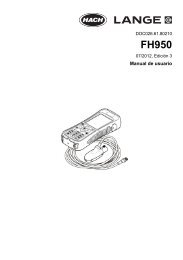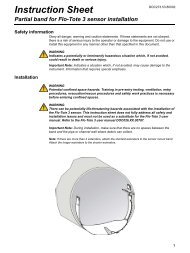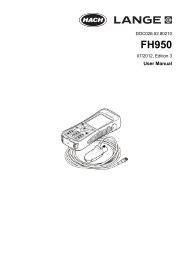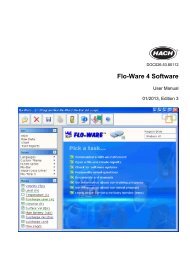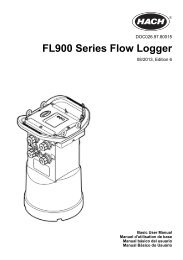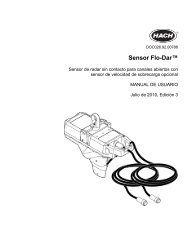DOC023.53.80040 sc200 Controller - Hachflow
DOC023.53.80040 sc200 Controller - Hachflow
DOC023.53.80040 sc200 Controller - Hachflow
Create successful ePaper yourself
Turn your PDF publications into a flip-book with our unique Google optimized e-Paper software.
Figure 24 Pulse Width Modulation function (linear mode)<br />
• Frequency Control Function (refer to Figure 25)<br />
1 High alarm 5 Period<br />
2 Deadband 6 Time (x-axis)<br />
3 Setpoint 7 Phase<br />
4 Low alarm 8 Selected source (y-axis)<br />
Option<br />
Set mode<br />
Phase<br />
Set setpoint<br />
Dead zone<br />
Pulse width<br />
Minimum<br />
pulses<br />
Maximum<br />
pulses<br />
Prop band<br />
Integral<br />
Description<br />
Auto—The relay works as a PID controller.<br />
Manual—the signal is controlled by the user through manual<br />
adjustment of the % change value. This option is shown as<br />
Manual Output after the manual set mode is selected.<br />
Reverses the leading sign of the control deviation for the PID<br />
controller (default: Reverse). The phase selects whether the<br />
relay will operate at the first part of a cycle (direct phase) or<br />
the second part (reverse phase).<br />
Sets the process value which is controlled by the PID<br />
controller.<br />
In this set range, the PID controller does not take action to<br />
change the output frequency until within the limits of the dead<br />
zone.<br />
Sets the cycle duration (0-600 seconds) of the PWM output<br />
signal. (default: 0.5 seconds) The cycle duration is equal to<br />
the duty cycle of the output signal.<br />
Sets the minimum number of pulses per minute at which the<br />
relay can operate. Range: 0.001–4.000 (default: 1.000)<br />
Sets the maximum number of pulses per minute at which the<br />
relay can operate. Range: 0.001–60.000 (default: 04.000).<br />
This value cannot be set lower than Minimum Pulses value.<br />
Sets the proportional part of the PID controller. The<br />
proportional part of the controller supplies an output signal<br />
which is linearly dependent to the control deviation. The<br />
proportional part reacts on any changes at the input but starts<br />
to oscillate easily if the value is set high. The proportional part<br />
cannot fully compensate for disturbances.<br />
Sets the derivative part of the PID controller (default:<br />
000 minutes). The integration part of the controller generates<br />
an output signal. The output signal increases linearly if the<br />
control deviation is constant. The integration part responds<br />
slower than the proportional part and can fully compensate<br />
disturbances. The higher the integration part, the slower it<br />
responds. If the integration part is set too low, it starts to<br />
oscillate.<br />
English 35


